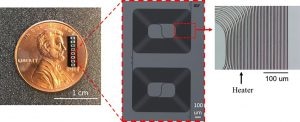Sep 18 2019
A microchip to map the back of the eye for disease diagnosis has been used by researchers in Christine Hendon’s and Michal Lipson’s study groups at Columbia University, New York.
 0.4 m long Si3N4 delay line confined within 8 mm2 area, with an integrated platinum heater. (Image credit: Columbia University)
0.4 m long Si3N4 delay line confined within 8 mm2 area, with an integrated platinum heater. (Image credit: Columbia University)
The interference technology, like bat sonar but using light rather than sound waves, used in the microchip has been in existence for some time now. This is the first time that technical hurdles have been resolved to make a tiny device capable of capturing superior quality images.
Ophthalmologists’ existing optical coherence tomography (OCT) devices and surveyors’ light detection and ranging (LIDAR) machines are bulky and costly. There is a demand for miniaturization so as to produce inexpensive handheld OCT and LIDAR that are sufficiently small to be added into self-driving cars.
In AIP Photonics, by AIP Publishing, the researchers illustrate their microchip’s ability to create high-contrast OCT images 0.6 mm deeper in human tissue.
Previously, we’ve been limited, but using the technique we developed in this project, we’re able to say we can make any size system on a chip. That’s a big deal!
Aseema Mohanty, Study Co-Author, Columbia University
Author Xingchen Ji is likewise enthusiastic and hopes the work gets industry funding to build a small, completely integrated handheld OCT device for inexpensive deployment outside of a hospital in low resource locations. Evidently seeing the benefits of miniaturization in interference technologies, both the National Institute of Health and U.S. Air Force sponsored Ji’s project.
Vital to chip-scale interferometer is the making of the adjustable delay line. A delay line computes how light waves interact, and by tuning to various optical paths, which are akin to different focal lengths on a camera, it organizes the interference pattern to create a high-contrast 3D image.
Ji and Mohanty coiled a 0.4-meter Si3N4 delay line into a small 8 mm2 area and incorporated the microchip with micro-heaters to optically tweak the heat-sensitive Si3N4.
By using the heaters, we achieve delay without any moving parts, so providing high stability, which is important for image quality of interference-based applications.
Xingchen Ji, Study Author, Columbia University
However, with components securely bent in a compact space, it is difficult to avoid losses when altering the physical size of the optical path. Earlier, Ji was able to enhance fabrication to stop optical loss. He applied this technique together with a new tapered region to precisely stitch lithographic patterns together—a vital step for realizing large systems.
The researchers showed the tunable delay line microchip on a present commercial OCT system, revealing that deeper depths could be explored while preserving high-resolution images.
This method should be relevant to all interference devices, and Mohanty and Ji are already beginning to expand LIDAR systems, one of the largest photonic interferometry systems.